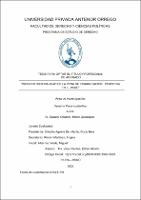| dc.contributor.advisor | Vera Infantes, Edder Alberto | |
| dc.contributor.author | Salazar Crisanto, Milton Guisseppe | |
| dc.creator | Salazar Crisanto, Milton Guisseppe | |
| dc.date.accessioned | 2023-11-30T14:06:05Z | |
| dc.date.available | 2023-11-30T14:06:05Z | |
| dc.date.issued | 2023 | |
| dc.identifier.uri | https://hdl.handle.net/20.500.12759/13111 | |
| dc.description.abstract | En el Perú, el sistema de penas se basa fundamentalmente en las “teorías relativas de la pena”, esto es, aquellas que señalan que la pena no tiene que tener un fin meramente retributivo y cuando se refiere a la pena no solamente se refiere a la pena privativa de libertad sino a todas las penas que el ordenamiento jurídico nacional señala; de ahí, que esta finalidad o esta función de la pena le sea también adscrita a la pena de inhabilitación, ya que si bien es cierto no se limita el derecho a la libertad si se limitan otros derechos fundamentales de la persona. En ese sentido, es necesario hacer un análisis - tal y como se hizo con la pena privativa de libertad perpetua, en su momento, por parte del Tribunal Constitucional- sobre la constitucionalidad de admitir la supresión de esos derechos o la restricción de sus derechos vía la pena de inhabilitación de forma indeterminada en ello es la inhabilitación perpetua.
La investigación se justificó básicamente en la necesidad de crear un criterio que limite la aplicación perpetua de la inhabilitación, habida cuenta que la legislación penal debe desarrollarse siempre con respeto de los derechos fundamentales y no con su restricción o eliminación absoluta. Se Consideró que si se pone un límite la inhabilitación tendríamos una pena que respete los estándares de humanidad bajo el principio justamente humanidad y proporcionalidad de las penas.
En función a la doctrina y además también teniendo en consideración lo vertido para la pena privativa de libertad que también tendría que aplicarse a la pena de inhabilitación, se ha utilizado el método doctrinario para establecer las posturas de la doctrina, se ha usado también el método hermenéutico para analizar justamente la pena de inhabilitación y su regulación, el método analítico, para hacer un análisis de los acuerdos plenarios relacionados a la pena de inhabilitación (como jurisprudencia); y, en función al análisis documental y el fichaje, se ha logrado comprobar la hipótesis y arribar a las conclusiones | es_PE |
| dc.description.abstract | In Peru, the penalty system is fundamentally based on the ““relative theories of the penalty““, that is, those that indicate that the penalty does not have to have a merely retributive purpose and when it refers to the penalty, it does not only refer to the custodial sentence but to all the sentences that the national legal system indicates; Hence, this purpose or this function of the penalty is also attached to the penalty of disqualification, since although it is true, the right to liberty is not limited if other fundamental rights of the person are limited. In this sense, it is necessary to carry out an analysis - as was done with the life imprisonment sentence, at the time, by the Constitutional Court - on the constitutionality of admitting the suppression of those rights or the restriction of their rights via the penalty of indeterminate disqualification in this is perpetual disqualification.
The investigation was basically justified by the need to create a criterion that limits the perpetual application of disqualification, taking into account that criminal legislation must always be developed with respect for fundamental rights and not with their restriction or absolute elimination. It was considered that if the disqualification is limited, we would have a sentence that respects the standards of humanity under the principle of just humanity and proportionality of the sentences.
Depending on the doctrine and also taking into account what is discharged for the custodial sentence that would also have to be applied to the penalty of disqualification, the doctrinal method has been used to establish the positions of the doctrine, the method has also been used hermeneutic to analyze precisely the penalty of disqualification and its regulation, the analytical method, to make an analysis of the plenary agreements related to the penalty of disqualification (as jurisprudence); and, based on the documentary analysis and the signing, it has been possible to verify the hypothesis and reach the conclusions. | es_PE |
| dc.description.uri | Tesis | es_PE |
| dc.format | application/pdf | |
| dc.language.iso | spa | es_PE |
| dc.publisher | Universidad Privada Antenor Orrego | es_PE |
| dc.relation.ispartofseries | T_DEREP_032 | |
| dc.rights | info:eu-repo/semantics/openAccess | es_PE |
| dc.rights.uri | https://creativecommons.org/licenses/by/4.0/ | es_PE |
| dc.source | Universidad Privada Antenor Orrego | es_PE |
| dc.source | Repositorio Institucional UPAO | es_PE |
| dc.subject | Derecho Penal | es_PE |
| dc.subject | Penas | es_PE |
| dc.title | Inconstitucionalidad de la pena de inhabilitación perpetua en el Perú | es_PE |
| dc.type | info:eu-repo/semantics/bachelorThesis | es_PE |
| thesis.degree.grantor | Universidad Privada Antenor Orrego. Facultad de Derecho y Ciencias Politicas | es_PE |
| thesis.degree.name | Abogado | es_PE |
| thesis.degree.discipline | Derecho | es_PE |
| dc.subject.ocde | http://purl.org/pe-repo/ocde/ford#5.05.00 | es_PE |
| renati.advisor.orcid | https://orcid.org/0000-0002-1565-2613 | es_PE |
| renati.author.dni | 72634354 | |
| renati.advisor.dni | 42405171 | |
| renati.type | http://purl.org/pe-repo/renati/type#tesis | es_PE |
| renati.level | http://purl.org/pe-repo/renati/level#tituloProfesional | es_PE |
| renati.discipline | 421016 | es_PE |
| renati.juror | Ortecho Aguirre De Infante, Rocio Belú | |
| renati.juror | Rincón Martínez, Angela | |
| renati.juror | Albornoz Verde, Miguel | |
| dc.publisher.country | PE | es_PE |




